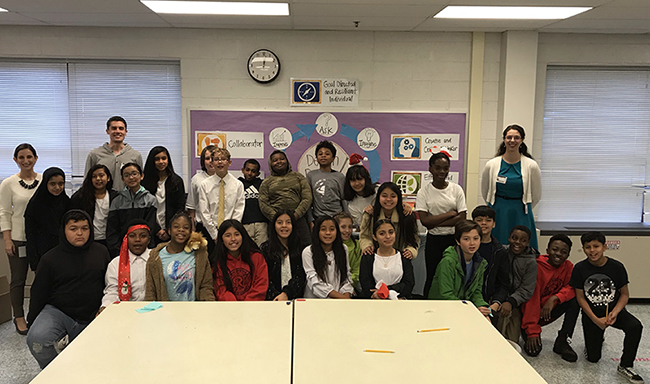Yesterday was a field day! Brian Moran, former VP of Product, asked us if we wanted to meet with Riverside Elementary School STEAM students to give them an inside view of what it is like to be a coder and data scientist. Of course, we said yes! Two of our data scientists, Heather Krieger and Eric Buras spoke to a group of 6th-grade STEAM (Science, Technology, Engineering, Art, and Math) students at Riverside Elementary School about computer science and coding careers.

To kick things off, Heather and Eric explained a bit about what Savi does. Savi helps companies make their supply chain more efficient. One way we do this is by giving them visibility into when their shipments will arrive. This is a big problem for most shippers. Eric and Heather talked about how our products use a company’s supply chain data to identify a number of things, such as which carriers and lanes perform best and where the most risk is for theft and diversion of high-value goods.
While the students had a good handle on what coding was, they weren’t as clear on what a data scientist was. Heather explained that data scientists use information (data) and historical statistics to predict when shipments will arrive. They look at information like where and when the shipment left its point of origin, what mode it takes (truck/rail/ocean/air), what route it takes, where the destination is and so on. Eric added that other information used might include how long historically that particular route has taken, whether that carrier has a good timeliness record or is often late to drop off shipments.
After their presentation, it was on to Q&A. There were some really good questions!
How did you become data scientists?
Each of us came here from different places. (Heather) I studied psychology and Eric studied math in college, yet we both ended up as data scientists. Eric told the students, “I wish that there was an opportunity to learn about technology this early, it would have been great preparation for my first job.”
Do you have to go to coding school?
No, we both knew people who taught themselves. Yes, we did learn some things in school and some we taught ourselves. It helps to have a good foundation which can be learned in class. Both mentioned that they spent a lot of time learning on the job. “It really helps if you are self-motivated and look for examples to teach yourselves new programming languages,” said Heather. ” Once you learn one language, it’s much easier to learn others. Eric and Heather shared how each had taught themselves Python.
What do you like most about your job?
“Solving puzzles/problem-solving is great; also the freedom to try different methods.” It’s cool that coding can be done from anywhere, you don’t have to be in an office necessarily. “Being able to work with the latest and greatest technology is fantastic. We are lucky to have a really nice work environment and a boss that gives us the freedom to try new ideas, make mistakes and keep learning.”
Why is coding important?
Coding is used in so many places you might not know about. For example, everything displayed on the internet uses a coding language. It’s the foundation of all that is done online. Financial institutions (banks) rely on coding to handle transactions and online banking. All the cell phones and iPads you use have software which is coding in an application form.
How can coders impact the community?
We work with companies who ship everyday products, like toothpaste to help them more accurately predict when their packages will arrive. Knowing precise ETAs help companies save a LOT of money. And when companies are able to manage their supply chain better, they have happier customers.
What does coding mean to you?
Eric: “Coding is a bit like writing. If you had to write a book report, you use words to describe something. We write code to describe our system. Coding gives you the freedom to express yourself, which I like.”
Heather: “Just like music has a structure to it, coding has a structure to it. Once you learn the structure, you can use it to create anything you like in new and different ways.
Savi thanks STEAM teacher Virginia “Molly” Fisher for hosting us. We had a really fun time talking to your students. Who knows what problems STEAM kids will solve in the future? We expect great things from you, #riversidecodes!
A big shout out also to Brian Moran and Sarah Eastman, founders of Boolean Girl, a tech non-profit which runs summer camps and after-school programs, where elementary-school-aged girls learn to code, animate and innovate from other young women in STEM.
